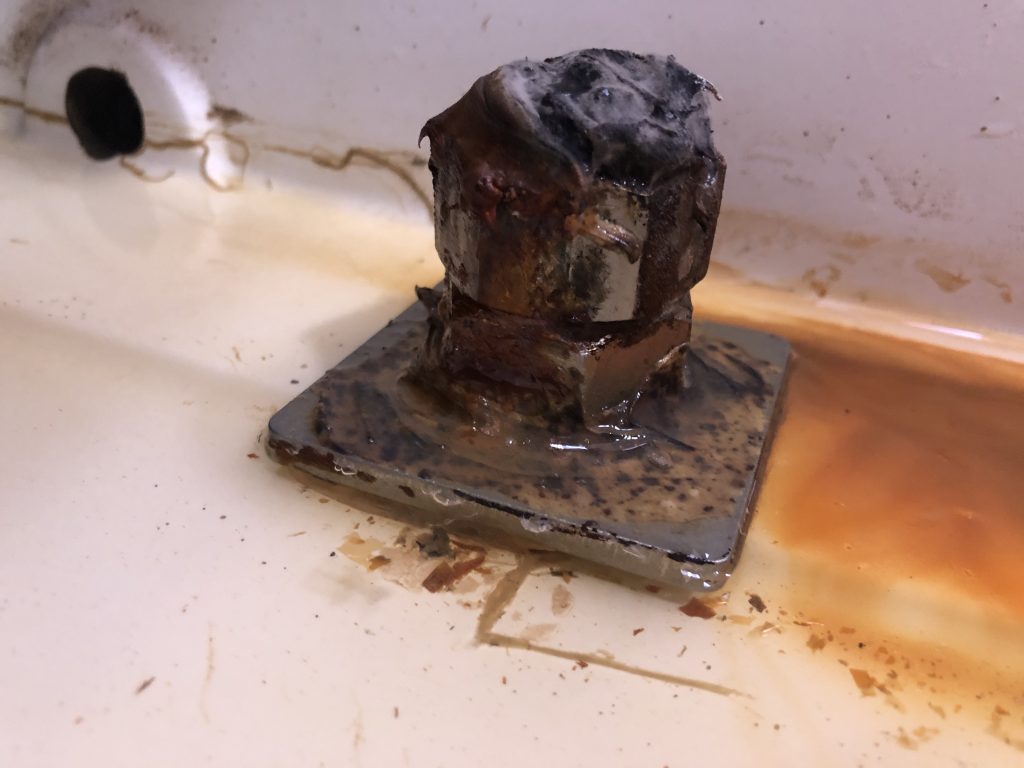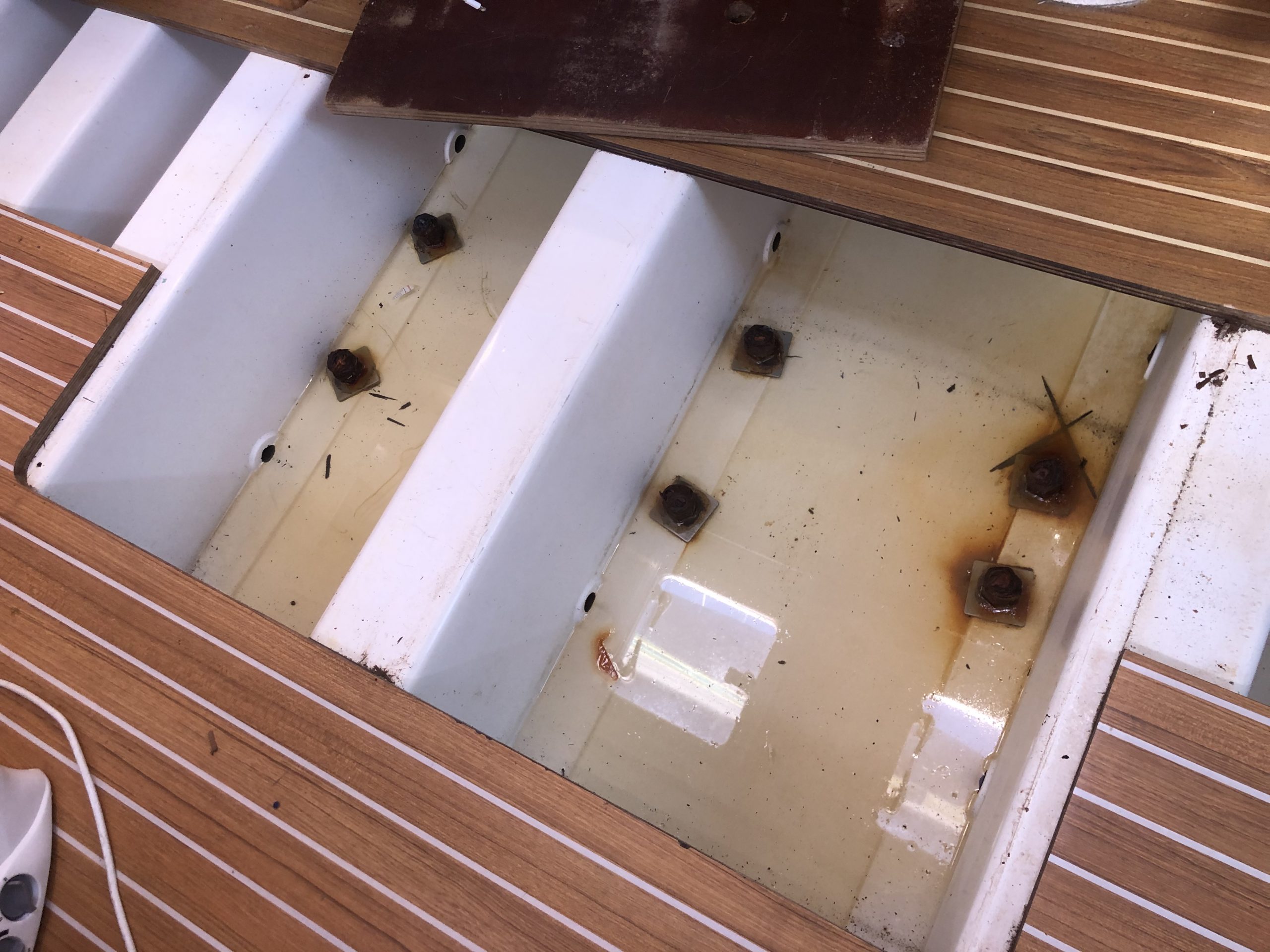Yeah, it’s been on my todo-list for some time now, to remove the sofa and peek under it in the bilge that doesn’t have any other ways to access it.
Guess if i was expecting the worst? In my mind I saw a bilge that had near to never been cleaned out, with dirt, grime and HAIR all over. *brrr* Nasty thoughts!
So I procrastinated by ordering some more things on internet! It works really well, even if it is expensive. Inox.ie got a visit. Damn, I really like a shop that has all its ducks in a row. So simple, so fast, so expensive. Ordered some more hose clamps (you can’t have too few hose clamps!), more screws as I noticed that there were some longer variants used on the boat that I didn’t have. Aparently decking screws, but I’m not picky. Can be useful that they are self-drilling.
I also remembered that I needed some really needed items, like an EPIRB (Emergency position indication radio beacon, yeah, it reall rolls off your tounge) and a new DST-800, or Depth-Speed-Temperature sensor. There is no thing as motivating as spending large amounts of money on tiny things that is just expected to be on a boat. Well, the EPIRB might be an uncommon sight in a sailboat that never leaves the coast, but a water speed sensor is something most boat has, as well as a depth sensor. The thermometer might not be as useful as the other three but it can be a nice thing to have when it is time for that morning dive. I also ordered a pair of binoculars – with compass, of course – a pair of flash lights that is marine grade and a ditch bag that I will add things to as we go. The ditch bag goes hand in hand with the EPIRB.
An EPIRB is used whenever you need to leave the boat and get into the life raft, the ditch bag has all the necessities to survive for a while in the life raft. There is by the way only one time that it is the correct action to do: when your boat is no longer capable to work as a boat, i.e. it is sinking or is in flames. The rule is: You step UP into the life raft. Simple, right? The boat is always safer than the life raft in every other case. Lost auxiliary power? Rudder? Sails? Mast? Stay on board. So, what is the EPIRB for then? It will transmit a signal via radio and satellite that an incident has happened, where you are and continously do so for at least 48 hours, some can do it for 72 hours or longer and thus a coast guard is alerted as well as any near by ships. So if you want to have any hopes of getting rescued you should make sure that you got the EPIRB wth you as you step off the boat. It will turn on automatically as soon as it gets into water, which is practical since it is a stressful situation and it can be forgotten. Some even have radar detection and response, which is kind of cool. When it detects a radar signal it transmits a number of pulses that shows up on that radar as a dotted line! In the closest end is you, very practical. So remember if you ever see a line of dots on your radar, that is a person in distress!
Anyway, good things to have on a boat. And now I felt that I had postponed the inevitable long enough. To the story comes that the floor that holds the sofa is in shambles. Well, it is severely water damaged anyway, as in there-has-been-water-standing-in-the-bilge-long-enough-to-delaminate-the-plywood-kind. So I was really preparing for the worst, as I mentioned above.
I removed the three screws holding it to the boat, the fourth was missing its head, so it was just a matter of lifting it straight up to get it out, partly because that corner of the floorboard was disintegrated. What I saw under the sofa was… a surprise in many ways, both positively but also negatively. There was water. About 4 cm deep. Which meant that the keel bolts was standing in water, for how long I don’t know, but long enough that a “skin” had formed on the surface, so possibly the whole winter, but probably many, many days in the past as well, as I soon found out.
Not the funniest view, for sure, but the water was expected since there has been so much condensation on the boat after I moved in. It won’t be such a big issue when I get her into warmer waters, but as long as I’m in Ireland I will have to count on cleaning out the bilge every now and then. So a bonus is clean a clean bilge, yay! All in all I removed nearly 40 liters of water in the bilge before I was done. Incredible!
But the water wasn’t the bad discovery really, no the bad one was that… the keel bolts isn’t stainless. And as an extra bonus someone had noticed that the keel bolts sometimes stand under water. So what to do about it?
So.
What.
To.
Do.
About.
It?
Yes, some of you might already have guessed it… Sili-f**n-cone! Seriously, what is it with this silicone fetish that someone has had with this boat?? Silicone is all good and fun, but not as a sealant on a boat! Why? Because it doesn’t really adhere well. Especially not to metal. What someone has done is to add a “protective” cap of silicone to each keel bolt, to try to prevent them to rust the next time they get under water. Seriously. Silicone on metal is probably the poorest choice you could do.

Most of the keel bolts shows different stages of corrosion, and adding a layer of silicone just helps that process. Do you see the dark spots on the square washer in the closest corner? Yep, that is UNDER the silicone. Mold, if I’m not misstaken. Peeling off the silicone was shockingly simple. I didn’t really have to use any tool to remove it, but I could easily get a razor blade in under the silicone and then just pull it off. The cap of silicone broke of easliy too, because it was sitting on top of a layer of corroded steel. So after cleanup it looked like this instead.

Why I’m really frustrated over the silicone is that it did exactly the opposite than what the person that put it there intended to. Now, with the silicone, the bolts was constantly wet since it had creeped its way in under the silicone. I presume that the bolts was corroded already when the silicone was applied, so it was futile to even try. The silicone actually prevented the bolts to dry out whenever anyone made sure to dry out the bilge. Fantastic. What they could have tried would have been to paint them with a rust converter that could stop the corrosion and get most of the oxide off the bolts. And then paint them with a paint that is meant to inhibit oxidation, like a paint with zink in it. But nooo…! SILICONE! Solves absolutely no boat-related issue, ever.
If anyone, ever, would honestly suggest to use silicone on a boat you are allowed to punch the person in the face. I promise.
As you can see in the last picture the bolt (the dark “tip” above the nuts) is quite corroded. This one is one of the worst, but my problem is that I don’t know how the rest of the bolt looks like. And there is just one way to find out. To undo the nuts holding the bolt that, hopefully, holds the keel. Normally you do one at a time, so there is no need to drop the keel and make this a bigger affair of it than it already is.
But.
Removing the nuts won’t be an easy task, since that bolt is rusted inside them and rust expands the bolt as well as it makes it brittle. So I have multiple scenarios in front of me:
- The nuts comes of surprisingly easy (after drenching them for days, most likely, with rust remover and the rest of the bolt looks healthy enough to keep (not a likely scenario).
- The nuts comes off, but puts up a fight, after the same treatment as above and the bolts are a sad sight that needs to be replaced. Removing them from the keel is also a challenge, but they surrender eventually (I wish this is the scenario that will come true).
- When trying to remove the nuts, the bolt gives up its ghost and breaks. Somewhere, below where it isn’t possible to see or work with it. A lot of swearing and cussing will ensue and the entire keel will have to come off. Maybe it is possible to still unscrew the keel bolts from the keel, but most likely one or more will have to be drilled out, new threads has to be tapped into the keel and an inset will probably be added to keep the same diameter of the keel bolts, so that there won’t be any need to drill out the ones in the boat. I really wouldn’t want to do that. This is the alternative that will break the bank and that I dread.
- I talk to the people here in the boat yard, they give it a hard eye and says that they will be fine for many years to come. Right.
So… Yeah…


One thought on “Bilge rat once again…”